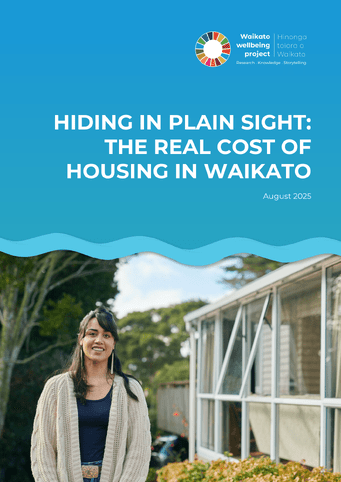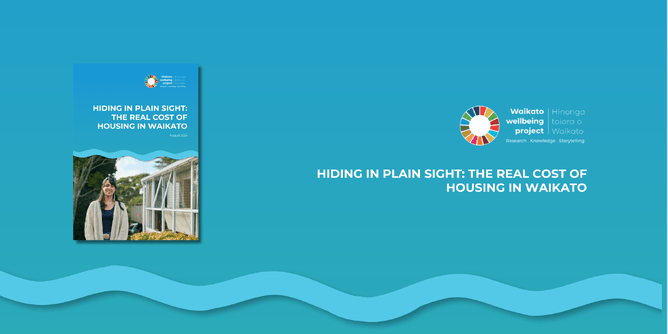In September, we issued the final version of our housing report “Hiding in Plain Sight: The Real Cost of Housing in Waikato”
Key Summary Points
Key regional indicators—such as the median house price of $740,000 and a regional median household gross income of $116,7226—reveal a price-to-income ratio of approximately 6.4:1, signalling a deepening affordability crisis across the Waikato region.
These structural imbalances entrench long-term financial stress, limit pathways to home ownership, and reflect a systemic decoupling of housing costs from local income realities (Infometrics, 2025; REINZ, 2025; Stats NZ, 2025).
While Waikato's overall price-to-income ratio sits close to the national median, the regional average masks substantial variation. Housing affordability pressures are acute in subregions such as Hamilton, Huntly, and Tokoroa, where local household incomes are significantly lower but housing costs are comparable to higher-income centres.
This creates disproportionate stress for lower-income whānau even though the Waikato region, in aggregate, remains mid-range in national affordability rankings. If house prices continue to grow faster than incomes, the time required to save a deposit could stretch from 13 years today to 21 years by 2035 and 28 years by 2045.
Without change, housing will continue to drift further out of reach for many, entrenching long-term inequality and financial stress. This raises the risk of locking younger generations into a permanent renting class, even if house prices stall in the short term—a theme increasingly visible in public debate.
The report was profiled in the Waikato Times- which can be read here.
A webinar on the report and its findings was held on 15 October. Presented by Quanita Ali from Datanomics Ltd, the webinar explored the main themes of the report and some of its initial policy and action recommendations. You can see a recording of the webinar here.
Community Housing Aotearoa
Community Housing Aotearoa (CHA) is a peak body for Aotearoa’s community housing sector. Community housing is a form of affordable housing working alongside private housing in the open market. Typically, community housing organisations are not-for-profit groups meeting housing need through a range of affordable rental and home ownership options. They provide an alternative to the public housing provided by Kāinga Ora (formerly Housing New Zealand) and local authority housing.
Community Housing Organisations provide around 19,200 homes throughout New Zealand, housing approximately 30,000 people. Its 175+ members include community housing providers and partner members such as developers, consultants and local councils.. CHA is committed to a vision where every New Zealander is well-housed in a warm, safe, dry and affordable home. This is a human right.
Recently, as part of its Deep Dive series, CHA Chief Executive Paul Gilberd sat down with some of the Waikato region’s housing champions and leaders, including Harvey Brookes, Thomas Gibbons and Mark Davies, as well as a range of leaders from across Aotearoa New Zealand. You can view all the Deep Dive stories here.
Where to Now?- How to Improve Affordability
The next phase of this work has now commenced, in partnership with Veros Limited. The purpose of this work is to identify and help advance real world solutions on what it would take to improve housing affordability in the Waikato region, addressing the issues identified in the above report.
There are many different elements to affordable housing including:
Where in the continuum housing is required (from homelessness to home ownership)
Which levers are available and are being deployed- such as land, finance and policy, to name just a few
What other actors in the system are doing- for example the government’s Going for Housing Growth Programme, community housing providers, iwi and private developers, funders and philanthropists
Whether a supply, demand-driven or mixed approach is taken
Whether actions aim to stabilise the market price of houses, or lower barriers to entry (e.g. rent to own, shared equity etc).
This work does not aim to ‘boil the ocean’, but rather to develop a practical, data-driven Investment model that identifies commercially feasible pathways for delivering affordable rental and ownership housing to middle-income households (earning $60,000–$150,000 annually) in the Waikato region.
This work will be grounded in what is commercially feasible for the private, community/for purpose and iwi development sectors and then reverse-engineer affordability from there. It is intended primarily to guide and support developers and housing providers who are committed to improving affordability for all.
The resulting model will be actionable, understandable, and relevant to the development community, adaptable across urban, peri-urban and rural community settings and focused on land that is development-ready.
The Veros team are keen to hear from people who have experienced the housing system, as a property developer/financer, landowner or first-time house buyer. If you’d like to share your views and ideas, please contact Morgan Jones (morgan.jones@veros.co.nz) or Paul Spurdle (pauls@veros.co.nz)



